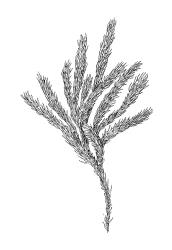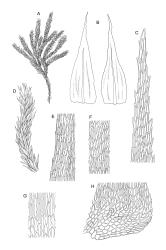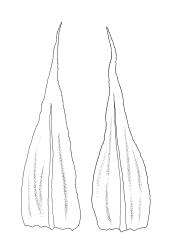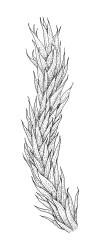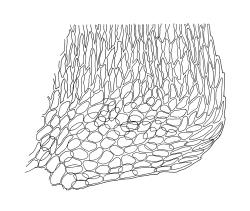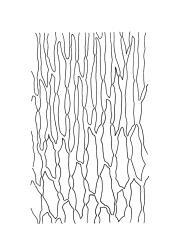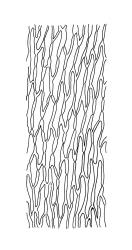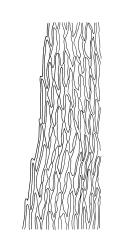- ≡ Hookeria leskeoides Hook., Musci Exot. 1, 55 (1818)
- = Isothecium nilgheriense Mont., Ann. Sci. Nat., Bot. sér. 2, 17: 246 (1842)
- ≡ Palamocladium nilgheriense (Mont.) Müll.Hal., Flora 82: 465 (1896)
- = Hypnum macrostegium Sull. & Lesq., Proc. Amer. Acad. Arts 4: 280 (1859)
- ≡ Palamocladium macrostegium (Sull. & Lesq.) Z.Iwats. & Takaki in Iwatsuki, J. Hattori Bot. Lab. 29: 58 (1966)
- = Astrodontium sericeum A.Jaeger, Ber. Thätigk. St. Gallischen Naturwiss. Ges. 1875–1876: 213 (1877)
- ≡ Palamocladium sericeum (A.Jaeger) Müll.Hal., Flora 82: 465 (1896)
Plants robust, rather wiry, golden to pale yellow- or pink-green, forming rather dense, often pendent mats. Stems creeping or pendent, branching irregular and ± fastigiate, 40–70(–100) mm long; rhizoids in very sparse fascicles, smooth and red-brown. Branches variable in length (but producing a smooth and even mat), c. 5–40 mm. Stems and branch leaves not differentiated, moderately homomallous (especially near branch tips), erect-spreading, straight, crowded, symmetric, strongly plicate for ⅔ or more of their length, weakly twisted at apex but otherwise not altered when dry, narrowly lanceolate from a subcordate base, plane at margins above, weakly reflexed at base, concave below, serrate or strongly serrulate above, less so towards base, 3.0–4.0 × c. 1.0 mm. Costa concolorous, c. 30–36 µm wide (⅓ above base), gradually tapered and becoming faint above, c. ¾ length of leaf (in N.Z. material), lacking an abaxial terminal spine. Upper laminal cells weakly prorate at upper end, firm-walled and porose, linear-flexuose, (33–)42–60(–81) × 3–6 µm, several rows shorter, broader, and strongly porose at insertion; alar cells forming a well-differentiated opaque group, ± quadrate.
Perichaetia with outer leaves scarcely differentiated from vegetative, the inner shorter (1.5–2.0 mm), either narrowly subulate or broadly acute from an oblong base, not plicate, ecostate, widely spreading. Male plants and sporophytes not seen in N.Z. material.
The overall appearance of P. leskeoides, with plants of a pink or golden hue forming neat and usually pendent mats over limestone, long (3–4 mm), narrowly lanceolate, ± cordate, and plicate leaves, makes it one of the most readily recognisable species of the Brachytheciaceae in N.Z.
Confusion in the field could occur with forms of Echinodium hispidum. When E. hispidum grows on limestone it can assume a pinkish cast not dissimilar to that of Palamocladium. However, the overall appearance of Palamocladium is much softer, the leaves narrowly lanceolate (vs abruptly narrowed from an ovate base to a stout subula in E. hispidum), the costae narrower and the leaf cells of a much different shape and length (linear-flexuose and mostly 42–60 µm long in Palamocladium).
NI: S Auckland (Piopio, Tawarau, Waitomo, Upper Awaroa River); SI: Nelson (Burnett Range, Devils Boots, Grove Reserve, Tākaka; Mt Arthur Range, Cobb Valley, Garibaldi Range, Ōpārara Range, Tiropahī River, Mt Owen Range), Marlborough (Leatham River).
Anomalous. South Africa*, southern Asia*. Recorded from North, Central, and South America, South and eastern Africa, southern and eastern Asia into Malesia by Hofmann (1997), who also provided a more detailed description that included sporophyte details.
On shaded, mesic to rather dry outcrops of limestone and marble, in forest (mostly southern beech dominated forest on the South I.) but extending into the alpine zone in sheltered rock crevices. Rarely epiphytic in N.Z. Specimens from epiphytic habitats have been seen from Bulmer Creek in the Mt Owen Range (on Brachyglottis hectorii and Olearia paniculata) and the Ōpārara Valley (on Melicytus ramiflorus). Recorded only in lowland situations (below 520 m) on the North I. On the South I. ranging from near sea level (Tākaka) to at least 1320 m (Mt Arthur Range). Associated mosses include Brachythecium paradoxum, Camptochaete deflexa, Cyathophorum bulbosum, Lembophyllum divulsum, Leptodon smithii, Sauloma tenella, Seligeria cardotii, and Weymouthia cochlearifolia.
While scattered in its N.Z. distribution, where it occurs P. leskeoides can be abundant and conspicuous. On an isolated outcrop of Cambrian “Summit Limestone” on the floor of the Cobb Valley (850 m elevation) it is abundant and forms pure, ± pendent mats of at least 0.3 m diameter.
Three names have been previously applied to N.Z. material of Palamocladium: P. macrostegium (Sull. & Lesq.) Iwats. & Takaki and P. nilgheriense (Mont.) Müll.Hal. were recorded by Bartlett (1984), and the name P. sericeum (A.Jaeger) Müll.Hal. was subsequently used by Fife (1995). Hofmann (1997) has placed all three of these names in the synonymy of P. leskeoides (Hook.) E.Britton, and her synonymy is accepted here.
Hofmann (1997) cited N.Z. specimens of P. leskeoides among the specimens she verified “in which the costa ends well below the leaf apex”; my observations, based on a larger suite of N.Z. collections, conform to hers. New Zealand material differs from Indian material available for study by having more distinctly porose mid laminal cells, and more robust and less curved branches. Hofmann’s (1997) description suggests that N.Z. material is at the upper end of leaf size range for the species.



